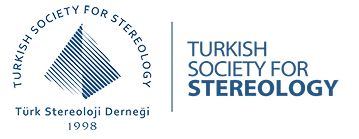Unbiased Stereological Techniques
Stereology is a branch of morphometry, which provide simple methods to estimate various parameters by a correct sampling design, without making biased assumptions about the shape and size of the object or the frequency of the interested particles, or cells. The results of stereological estimations can be considered as unbiased, i.e. free from systematic error, from all practical angles.
For Reading Article, please click here.
A Brief Introduction to Stereology and Sampling Strategies: Basic Concepts of Stereology
Stereology (from the Greek stereos = solid) is considered as the spatial interpretation of profiles seen in sections. It is a multidisciplinary science field dealing with the three-dimensional profiles of objects appearing on sectional planes of metallurgical materials or tissues. Stereology supplies practical techniques for obtaining quantitative information about three-dimensional, real-world structures from two-dimensional planar profiles. After acknowledging the fact that the profiles on sections are not true representations of the real objects, the need for stereology in quantitative studies becomes obvious. Stereological methods utilise various specific tools and sampling strategies to provide unbiased and quantitative estimates in order to obtain a wide range of quantitative parameters including the number, size, shape, volume and density.
For Reading Article, please click here.
The Disector Counting Technique
Number of particles in an organ or region is a valuable data as well as the volume. Many techniques have been developed for the estimation of total number or numerical density of cells in tissues and organs. The quality and reliability of each method has constantly been increased compared to its predecessors. Numerical density is one of the parameters that is used to assess the association between a structure and its function. It should be kept in mind that reliability of biological comments derived from the data is dependent on the method that is used for quantitative estimation of parameters. As stated previously, one of the most important morphometric parameters in biological studies is the ‘number’. Since the ‘number’ has no-dimensions (i.e. Is not bounded by any dimensional property) it could not be directly estimated using a 2D section plane. A good alternative is to use a “volume probe” generated by two consecutive sections, which is called the disector. The disector counting method that was developed by Stereo in 1984 is the most efficient and unbiased solution for particle counting.
For Reading Article, please click here.
An Unbiased Way to Estimate Total Quantities: The Fractionator Technique
The fractionator is a straightforward and unbiased method to estimate virtually any type of total quantity using sectional profiles of tissue particles. Its basic principle and ease of use make this approach is a method of choice in many microscopical quantitative studies.
For Reading Article, please click here.
Distribution of Particles in the Z-axis of Tissue Sections: Relevance for Counting Methods
The distribution of particles in the z-axis of thick tissue sections has gained considerable attention, primarily because of implications for the accuracy of modern stereological counting methods. Three major types of tissue section artifacts can affect particle quantification: loss of particles from the surfaces of tissue sections (lost caps), homogeneous collapse in the z-axis, and differential deformation in the z-axis. Initially it was assumed that thick sections were not compromised by differential shrinkage or compression (differential uniform deformation). Studies in the last decade showed that such artifacts are common and that they depend on the type of embedding media and sectioning devices. Paraffin, glycolmethacrylate and vibratome sections are affected by this artifact, but not celloidin- or cryosections. Differential distribution of particles in the z-axis is likely due to compression of the surface areas (margins) during sectioning, resulting in differential particle densities in the core and margins of tissue sections. This deformation of tissue sections can be rapidly quantified by measuring the position of particles in the z-axis. The analysis is complicated by potential secondary effects on section surfaces through loss of particles, the so-called “lost caps” phenomenon. Use of guard spaces can reduce the bias caused by secondary effects, while their use in case of primary effects (compression due to sectioning) would enhance the artifact’s impact on bias. Symmetric versus asymmetric patterns of z-axis distortion can give clues to distinguish primary and secondary effects. Studies that use the optical disector need to take these parameters into account to minimize biases.
For Reading Article, please click here.
References
1. Kaplan, S., Canan, S. Unbiased Stereological Techniques (2012, Editorial) Neuroquantology, Vol 10, No 1, pp: 9-10.
2. Altunkaynak, B.Z., Önger, M.E., Altunkaynak, M.E., Ayrancı, E., Canan, S. (2012) A Brief Introduction to Stereology and Sampling Strategies: Basic Concepts of Stereology. Neuroquantology, Vol 10, No 1, pp: 31-43.
3. Kaplan, S., Odacı, E., Canan, S., Onger, M.E., Aslan, H., Ünal, B. (2012) The Disector Counting Technique. Neuroquantology, Vol 10, No 1, pp: 44-53.
4. Kaplan, S., Canan, S., Altunkaynak, M.E., Odaci, E., Aslan, H., Unal, B. (2012) An Unbiased Way to Estimate Total Quantities: The Fractionator Technique. Neuroquantology, Vol 10, No 1, pp 54-65.
5. Bartheld, C. (2012) Distribution of Particles in the Z-axis of Tissue Sections: Relevance for Counting Methods. Neuroquantology, Vol 10, No 1, pp 66-75.

